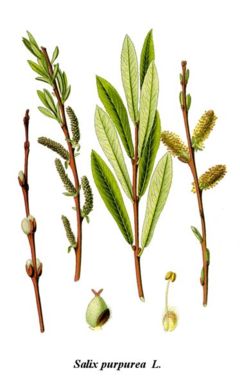Purple Willow
| Standard Cyclopedia of Horticulture |
|---|
|
Salix purpurea, Linn. (S. Forbyana, Smith. Vetrix purpurea, Rafin.). Purple Osier. Fig. 3526. A shrub or small tree, spreading at base, with long, flexible branches: lvs. oblanceolate, serrulate, glabrous, veiny, 3-6 in. long, often appearing opposite: aments sessile, slender; pistillate recurved; scales purple; stamen 1: caps. small, ovate. Eu.—Planted as an ornamental shrub and escaped in many places. Also grown as a basket-willow. Var. pendula, Dipp. (S. nigra pendula, Hort. S. Americana pendula, Hort.). Branches pendent. Gng. 4:243.
|
| Purple Willow secure Fossil range: {{{fossil_range}}}
| ||||||||||||||||||||||||||||||||||||||||||||||||||||||||||||||||||
|---|---|---|---|---|---|---|---|---|---|---|---|---|---|---|---|---|---|---|---|---|---|---|---|---|---|---|---|---|---|---|---|---|---|---|---|---|---|---|---|---|---|---|---|---|---|---|---|---|---|---|---|---|---|---|---|---|---|---|---|---|---|---|---|---|---|---|
 Purple Willow illustration | ||||||||||||||||||||||||||||||||||||||||||||||||||||||||||||||||||
| Plant Info | ||||||||||||||||||||||||||||||||||||||||||||||||||||||||||||||||||
| ||||||||||||||||||||||||||||||||||||||||||||||||||||||||||||||||||
| Scientific classification | ||||||||||||||||||||||||||||||||||||||||||||||||||||||||||||||||||
| ||||||||||||||||||||||||||||||||||||||||||||||||||||||||||||||||||
| [[{{{diversity_link}}}|Diversity]] | ||||||||||||||||||||||||||||||||||||||||||||||||||||||||||||||||||
| {{{diversity}}} | ||||||||||||||||||||||||||||||||||||||||||||||||||||||||||||||||||
| Binomial name | ||||||||||||||||||||||||||||||||||||||||||||||||||||||||||||||||||
| Salix purpurea L. | ||||||||||||||||||||||||||||||||||||||||||||||||||||||||||||||||||
| Trinomial name | ||||||||||||||||||||||||||||||||||||||||||||||||||||||||||||||||||
| {{{trinomial}}} | ||||||||||||||||||||||||||||||||||||||||||||||||||||||||||||||||||
| Type Species | ||||||||||||||||||||||||||||||||||||||||||||||||||||||||||||||||||
| {{{type_species}}} | ||||||||||||||||||||||||||||||||||||||||||||||||||||||||||||||||||
| {{{subdivision_ranks}}} | ||||||||||||||||||||||||||||||||||||||||||||||||||||||||||||||||||
| [[Image:{{{range_map}}}|{{{range_map_width}}}|]] | ||||||||||||||||||||||||||||||||||||||||||||||||||||||||||||||||||
| Synonyms | ||||||||||||||||||||||||||||||||||||||||||||||||||||||||||||||||||
| {{{synonyms}}} |
The Purple Willow or Purple Osier (Salix purpurea) is a species of willow native to most of Europe and western Asia. It is a shrub to 1-2 m tall. The leaves are 2-8 cm long and 1-2 cm wide, and, unusually for a willow, often arranged in opposite pairs rather than alternate. The flowers are small catkins, produced in early spring; they are often purple in colour, whence the name of the species (other willows mostly have whitish, yellow or green catkins).
This willow species is often used in basketry.